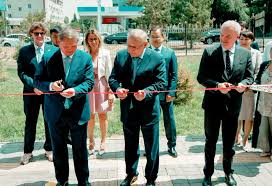How to build a Moon base

Next year, astronaut Matthias Maurer expects to walk on the surface of the Moon — but without the hassles of a rocket flight, zero-gravity nausea and a risky landing. Instead he’ll stroll close to home in a leafy meadow near Cologne, Germany, which is set to host the largest Moon mock-up ever made.
On a pit of artificial lunar dust covering more than 1,000 square metres, Maurer and other scientists will be attached to crane-and-pulley systems that allow them to leap as if experiencing the Moon’s weaker gravity, and work under adjustable lamps that simulate lighting at different lunar sites. Sometimes, they will retreat to lunar-style living quarters: an airlock-connected module the size of a shipping container.
It’s an exciting playground for testing lunar technology, says Maurer, who is a project manager for the multimillion-euro facility. Called LUNA, the mock-up is taking shape outside the European Astronaut Centre in Cologne, with funding from the European Space Agency (ESA) and the German Aerospace Center (DLR). But at 48 years old, Maurer doesn’t know whether he will ever put his skills to use on the genuine article. “Hopefully I will make it before retirement. Technically, I believe it’s feasible that I will still walk on the Moon,” he says.
Maurer’s optimism isn’t entirely outlandish. He was only two the last time someone visited the Moon for real: US astronaut Eugene Cernan, in the last mission of NASA’s Apollo programme. No space agencies have yet committed money to send people back. But, partly as a result of changing political priorities, momentum for human return to the Moon is growing. Rather than rerun the Apollo missions, space agencies are slowly warming to the idea of establishing a sustainable settlement.
Researchers relish the idea of a base for conducting experiments on the Moon and as a way to trial technologies for heading to Mars. Private firms, however, are increasingly tempted by the possibility of mining oxygen and hydrogen — which power rockets — from lunar ice. If that does pan out, then the Moon could become a refuelling station, radically reducing the expense of space travel.
“Water is the oil of space, and there’s mounting evidence that it’s there in economically viable deposits,” says George Sowers, an aeronautical scientist at the Colorado School of Mines in Golden and previously chief scientist at United Launch Alliance, a firm in Centennial, Colorado, that provides launch services for the US government. Space agencies are generally reluctant to predict a timeline for a crewed





